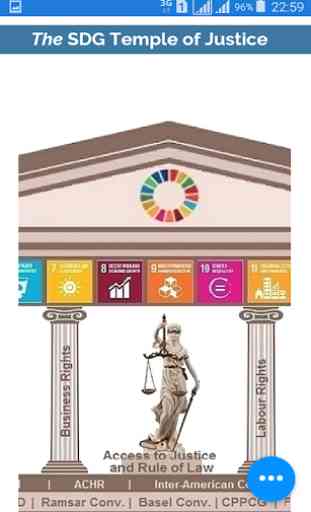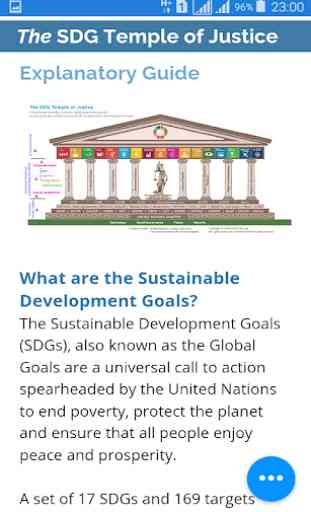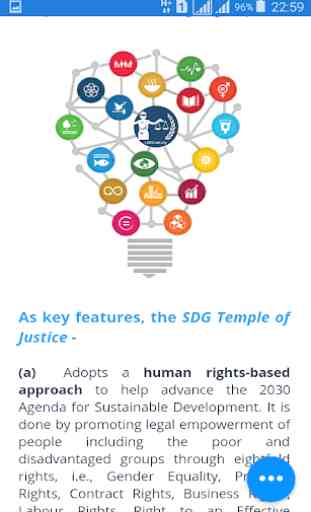SDG Temple of Justice
The SDG Temple of Justice is a business-friendly, human rights-based blueprint and a tool for accelerating the achievement of Sustainable Development Goals (SDGs).
It helps address “the greatest global challenge of eradicating poverty in all its forms and dimensions including extreme poverty” while “leaving no one behind” as stated in the 2030 Agenda for Sustainable Development by promoting legal empowerment of people through the eightfold rights mentioned below.
The infographic of the SDG Temple of Justice visualizes how the 2030 Agenda can be advanced by leveraging the human rights foundation of the SDGs through legal empowerment of people including the poor and disadvantaged groups.
As key features, the SDG Temple of Justice -
(a) Adopts a human rights-based approach to help advance the 2030 Agenda for Sustainable Development. It is done by promoting legal empowerment of people including the poor and disadvantaged groups through eightfold rights, i.e., Gender Equality, Property Rights, Contract Rights, Business Rights, Labour Rights, Right to an Effective Remedy, Right to Information, and the Right to Development.
Benefit: As a human rights-based development strategy, legal empowerment of people including the poor has the potential to help address the “greatest global challenge of eradicating poverty” which is the unifying thread throughout the 17 Goals and their 169 targets.
For more information, tap on the SDG colour wheel and the eight pillars of the SDG Temple infographic.
(b) Incorporates a human rights guide to the SDGs that shows the high degree of convergence between human rights and the Goals & targets (content credit: the Danish Institute for Human Rights).
Benefit: This guide helps using national, regional and international human rights monitoring and reporting mechanisms to undertake the “follow up and review” of SDG implementation. Preparing reports on sustainable development, e.g. Voluntary National Reviews (VNRs), based on existing human rights reporting procedures as recommended by the 2030 Agenda provides a constructive and resource-efficient advantage for States.
For a guide on the SDGs – human rights relationship, tap on the 17 SDG icons appearing on the SDG Temple infographic.
(c) Connects with the UN Treaty Collection’s current status of international human rights treaties and ILO regulations that are directly related to the SDGs.
Benefit: Being State Parties to all relevant international and regional human rights treaties contributes to the successful achievement of the 17 SDGs by 2030.
For a guide on the human rights – SDGs relationship, tap on the human rights treaty acronyms indicated on the steps leading to the SDG Temple.
It helps address “the greatest global challenge of eradicating poverty in all its forms and dimensions including extreme poverty” while “leaving no one behind” as stated in the 2030 Agenda for Sustainable Development by promoting legal empowerment of people through the eightfold rights mentioned below.
The infographic of the SDG Temple of Justice visualizes how the 2030 Agenda can be advanced by leveraging the human rights foundation of the SDGs through legal empowerment of people including the poor and disadvantaged groups.
As key features, the SDG Temple of Justice -
(a) Adopts a human rights-based approach to help advance the 2030 Agenda for Sustainable Development. It is done by promoting legal empowerment of people including the poor and disadvantaged groups through eightfold rights, i.e., Gender Equality, Property Rights, Contract Rights, Business Rights, Labour Rights, Right to an Effective Remedy, Right to Information, and the Right to Development.
Benefit: As a human rights-based development strategy, legal empowerment of people including the poor has the potential to help address the “greatest global challenge of eradicating poverty” which is the unifying thread throughout the 17 Goals and their 169 targets.
For more information, tap on the SDG colour wheel and the eight pillars of the SDG Temple infographic.
(b) Incorporates a human rights guide to the SDGs that shows the high degree of convergence between human rights and the Goals & targets (content credit: the Danish Institute for Human Rights).
Benefit: This guide helps using national, regional and international human rights monitoring and reporting mechanisms to undertake the “follow up and review” of SDG implementation. Preparing reports on sustainable development, e.g. Voluntary National Reviews (VNRs), based on existing human rights reporting procedures as recommended by the 2030 Agenda provides a constructive and resource-efficient advantage for States.
For a guide on the SDGs – human rights relationship, tap on the 17 SDG icons appearing on the SDG Temple infographic.
(c) Connects with the UN Treaty Collection’s current status of international human rights treaties and ILO regulations that are directly related to the SDGs.
Benefit: Being State Parties to all relevant international and regional human rights treaties contributes to the successful achievement of the 17 SDGs by 2030.
For a guide on the human rights – SDGs relationship, tap on the human rights treaty acronyms indicated on the steps leading to the SDG Temple.
Category : Business

Related searches





Practically useful app for national / international organizations implementing the Sustainable Development Goals (SDGs). The proposed rights-based approach is meaningful and it can be used as a guide to developing national human rights-based strategies to advance the SDGs.